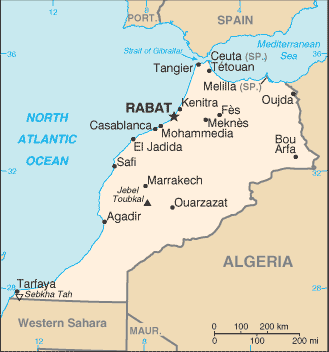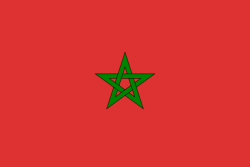Kingdom of Morocco
Related Categories:
 Morocco Historical Flags - Fotw
Morocco Historical Flags - FotwThe use of the flag in Morocco as a symbol of the state dates way back to the Almoravide dynasty (1062-1125 AD).
www.fotw.us/flags/ma_hist.html Morocco - wikipedia.org
Morocco is the only African country that is not currently a member of the African Union. However, it is a member of the Arab League, Arab Maghreb Union, the Francophonie, Organization of the Islamic Conference, Mediterranean Dialogue group, and Group of 77, and is a major non-NATO ally of the United States.
en.wikipedia.org/
Moroccans are predominantly Sunni Muslims of Arab, Berber, or mixed Arab-Berber ancestry. The Arabs brought Islam, along with Arabic language and culture, to the region from the Arabian Peninsula during the Muslim conquests of the 7th century. Today, there remains a Jewish community of approximately 5,000, and a largely expatriate Christian population of 5,000, who enjoy religious freedom and full civil rights. Morocco is also home to a 300-500-person Baha’i community which, in recent years, has been able to worship free from government interference.
Arabic is Morocco's official language, but French is widely taught and serves as the primary language of commerce and government. Moroccan colloquial Arabic is composed of a unique combination of Arabic, Berber and French dialects. Along with Arabic, about 10 million Moroccans, predominantly in rural areas, also speak one of the three Moroccan Berber dialects (Tarifit, Tashelhit, and Tamazight). Spanish is also used in the northern part of the country. English is rapidly becoming the foreign language of choice among educated youth and is offered in all public schools from the fourth year on.
Most people live west of the Atlas Mountains, a range that insulates the country from the Sahara Desert. Casablanca is the center of commerce and industry and the leading port; Rabat is the seat of government; Tangier is the gateway to Spain and also a major port; "Arab" Fes is the cultural and religious center; and "Berber" Marrakech is a major tourist center.
Education in Morocco is free and compulsory through primary school (age 15). Nevertheless, many children--particularly girls in rural areas--do not attend school. The country's literacy rates reveals sharp gaps in education, both in terms of gender and location; while country-wide literacy rates are estimated at 39% among women and 64% among men, the female literacy rate in rural areas is only 10%.
Morocco is home to 14 public universities. Mohammed V University in Rabat is one of the country’s most famous schools, with faculties of law, sciences, liberal arts, and medicine. Karaouine University, in Fes, is a longstanding center for Islamic studies and is the oldest university in the Maghreb. Morocco has one private, English language university, Al-Akhawayn, in Ifrane, founded in 1993 by King Hassan II and King Fahd of Saudi Arabia. The curriculum is based on an American model.
www.state.gov/r/
Introduction
About
Contact
Symbols in The News
Interpret this Symbol
AAC
African
AI
Alchemy
Alphabets
Ancient
Animal Symbolism
Architecture
Art
Articles
Astrology
Baha'i
Blissymbolics
Blueprint Symbols
Buddhist
Celtic Symbols
Cemetery
Chinese Symbols
Christian
Circle
City
Codes
Color
Conlangs
Crop Circles
Danger
Da Vinci Code
Designing Logos
Dictionaries
Dreams
Education
Egyptian Symbols
Electrical
Emoticons
Find Images
Fonts
Food
Fraternity
Hamsa
Healing
Heraldry
Hermetic
Highway Signs
Hindu
History
Hobo
Holiday
Icons
iConji
Islamic
Jain Symbols
Japanese, Kanji
Jewish
Justice
Law
Literary Symbolism
Mandalas
Map
Masonic
Math, Number
Meaning of Names
Medical
Middle East
Military
Miscellaneous
Money
Music
Mythology
Native American
Playing Cards
Power
Psychology
QiQiiKhu
Reiki
Religious
Runes, Norse
Sacred Geometry
Scientific
Science Fiction
Sorority
Sports
Symbols in the News
Tattoos
ThirteenSymbols
Tree of Life
Ursprache
Videos
Visual Languages
Weather
Web Codes
Wicca
Words
Writing Systems
Braille
Coinherence
Coptic
Cuneiform
Easter Island
Etruscan
Happy Human
Hebrew
Kokopelli
Linear B
Lotus
Love Symbols
Mandorla
Moon Alphabet
Nine Pointed Star
Om
Oz
Phonetic
Scarab Beetle
Silent
Theosophy
Unifon
About
Contact
Symbols in The News
Interpret this Symbol
AAC
African
AI
Alchemy
Alphabets
Ancient
Animal Symbolism
Architecture
Art
Articles
Astrology
Baha'i
Blissymbolics
Blueprint Symbols
Buddhist
Celtic Symbols
Cemetery
Chinese Symbols
Christian
Circle
City
Codes
Color
Conlangs
Crop Circles
Danger
Da Vinci Code
Designing Logos
Dictionaries
Dreams
Education
Egyptian Symbols
Electrical
Emoticons
Find Images
Fonts
Food
Fraternity
Hamsa
Healing
Heraldry
Hermetic
Highway Signs
Hindu
History
Hobo
Holiday
Icons
iConji
Islamic
Jain Symbols
Japanese, Kanji
Jewish
Justice
Law
Literary Symbolism
Mandalas
Map
Masonic
Math, Number
Meaning of Names
Medical
Middle East
Military
Miscellaneous
Money
Music
Mythology
Native American
Playing Cards
Power
Psychology
QiQiiKhu
Reiki
Religious
Runes, Norse
Sacred Geometry
Scientific
Science Fiction
Sorority
Sports
Symbols in the News
Tattoos
ThirteenSymbols
Tree of Life
Ursprache
Videos
Visual Languages
Weather
Web Codes
Wicca
Words
Writing Systems
Braille
Coinherence
Coptic
Cuneiform
Easter Island
Etruscan
Happy Human
Hebrew
Kokopelli
Linear B
Lotus
Love Symbols
Mandorla
Moon Alphabet
Nine Pointed Star
Om
Oz
Phonetic
Scarab Beetle
Silent
Theosophy
Unifon

